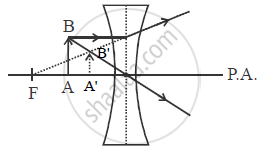Advertisements
Advertisements
प्रश्न
A virtual diminished image is formed when an object is placed between the optical centre and the principal focus of a lens.
(i) Name the type of lens which forms the above image.
(ii) Draw a ray diagram to show the formation of the image with the above stated characteristics.
उत्तर
(i) Concave lens
(ii) AB : Object
A'B' : Image

APPEARS IN
संबंधित प्रश्न
A small bulb is placed at the focal point of a converging lens. When the bulb is switched on, the lens produces:
(a) a convergent beam of light
(b) a divergent beam of light
(c) a parallel beam of light
(d) a patch of coloured light
Take down this figure into your answer book and complete the path of the ray.
What is the difference between the two images formed above?
When an object is placed 10 cm in front of lens A, the image is real, inverted, magnified and formed at a great distance. When the same object is placed 10 cm in front of lens B, the image formed is real, inverted and same size as the object.
What is the focal length of lens A?
When a fork is seen through lenses A and B one by one, it appears as shown in the diagrams. What is the nature of (i) lens A, and (ii) lens B? Give reason for your answer.
An object 60 cm from a lens gives a virtual image at a distance of 20 cm in front of the lens. What is the focal length of the lens? Is the lens converging or diverging? Give reasons for your answer.
An object is placed on the axis of a lens. An image is formed by refraction in the lens. For all positions of the object on the axis of the lens, the positions of the image are always always between the lens and the object Draw a ray diagram to show it.
- Name the lens which always forms an erect and virtual image.
- State whether the image in part (a) is magnified or diminished.
A student obtained clear image of window grills on the screen. But the teacher told him to get the image of a tree far away, instead of window. To get a clear image, the lens must be ............................
An object is placed at a distance 24 cm in front of a convex lens of focal length 8 cm.
(i) What is the nature of the image so formed?
(ii) Calculate the distance of the image from the lens.
(iii) Calculate the magnification of the image.
